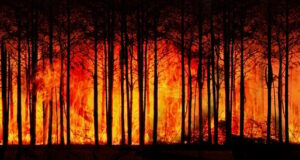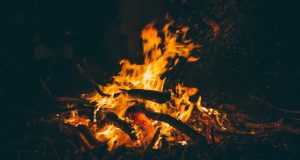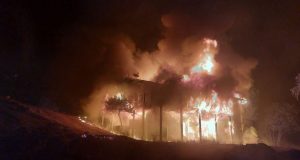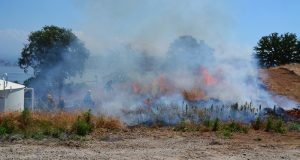 EASTMAN LAKE – Wildland firefighting in an inherently dangerous job. While the risk of injury is apparent, what has not been studied and addressed to any significant degree is the incredible stress to the body, and the exposure to cancer-causing substances in the Wildland Urban Interface (WUI). New technology is changing that.
EASTMAN LAKE – Wildland firefighting in an inherently dangerous job. While the risk of injury is apparent, what has not been studied and addressed to any significant degree is the incredible stress to the body, and the exposure to cancer-causing substances in the Wildland Urban Interface (WUI). New technology is changing that.
“We know that the number one killer of firefighters is heart attack and stroke,” says Dr. Matt Rahn, Director of Wildland Research at California State University San Marcos (CSUSM), “and incidents of cancer are significantly higher than the average population.”
This week, as 140 firefighters were put through their paces during a live fire exercise at Eastman Lake, some of those individuals were wired for data collection.
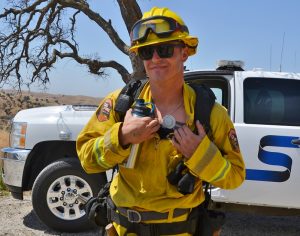 Firefighters were monitored in several different ways by researchers from CSUSM. They swallowed what was described as a “little purple pill” with Bluetooth capability from which data could be downloaded at the end of the day. Each participant also had a monitor strapped to their chest collecting data on respiratory rate and skin temperature, and carried a water bottle that measured the amount of water leaving through the cap.
Firefighters were monitored in several different ways by researchers from CSUSM. They swallowed what was described as a “little purple pill” with Bluetooth capability from which data could be downloaded at the end of the day. Each participant also had a monitor strapped to their chest collecting data on respiratory rate and skin temperature, and carried a water bottle that measured the amount of water leaving through the cap.
“We want to tag along as they are doing their regular job, being exposed to the elements, and working the way they normally do,” says Dr. Rahn, who is in the first phase of a two-year study. “Then we collect the data and look to see how hard their bodies are working.”
A few years ago, Rahn’s team conducted a study with about 100 firefighters and found that “these folks are going zero to sixty constantly.” Heart rates were pushing up to 220 beats per minute, which is way beyond what normal activity generates, and core body temperatures were bumping up against 104 degrees.
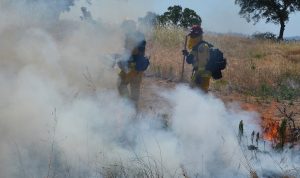 “Add into that a fire where you have vehicles, houses and other materials burning, and they’re breathing in all this horrible substance with no real respiratory protection other than perhaps a bandana over their face, and now you’re in some of the highest-risk environment on the planet and asking them to work in it for 24 hours.”
“Add into that a fire where you have vehicles, houses and other materials burning, and they’re breathing in all this horrible substance with no real respiratory protection other than perhaps a bandana over their face, and now you’re in some of the highest-risk environment on the planet and asking them to work in it for 24 hours.”
Rahn says addressing the issues faced by wildland firefighters is a generation behind those of structure fire personnel.
“We’re trying to figure out how bad the issue is first, and hopefully be able to identify new protocol, protective equipment or operational procedures to protect these folks from the risks.”
As Rahn’s team monitors heart rates and core body temperatures, they are drawing correlations between those numbers and the ingestion of water. Each of the participating firefighters had a water bottle with a thermostatic sensor that measures when and how much water leaves through the cap, and the subsequent effect on their physiology.
“One of the things we noticed in the last study is that core temperature and heart rate track each other extremely closely,” says Rahn. “As one goes up, so does other. The hotter you get, the more viscous your blood becomes, and the harder your heart has to work to push that blood. If you ingest water that’s cooler than the core body temperature, it reduces that temp and has the effect of reducing the heart rate. We need good protocols for hydration.”
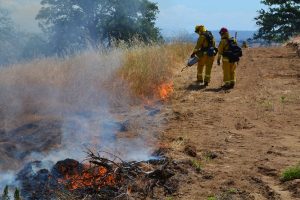 The technology is all new, and the study the first of its kind, says Rahn.
The technology is all new, and the study the first of its kind, says Rahn.
“We’ve never had the ability to test on working individuals how water intake affects their physiology.”
Firefighters working in the WUI face more than stress to the body. The smoke from burning trees and vegetation is joined by dangerous substances emitted when things burn such as cars and buildings.
“This is the first time we’ve looked at wildland firefighter contamination and risk exposure,” says Rahn.
Clothing, gear and skin are swabbed after a firefight, and tested for an array of hazardous substances.
“We’re not going to solve the exposure issue today,” says Rahn. “This is a two-year study, and we’re in the first phase, establishing base lines. We’re trying to understand what the contamination and risks are by going to the actual incidents themselves. We’ll take that data and hone in on where the big issues are.”
On the research and education side of this important process is the establishing a new bachelors degree in wildland interface at CSU San Marcos.
“This is the first of its kind in the country,” says Rahn. “We got approval from the state of California last week, and will be launching the new degree program this fall.
“Right now, you have an associate’s degree that typically includes such things as natural resource management and forestry, but nothing specific to a wildland degree. So now we’ll offer a two-year completion degree so those who come in with an associate’s degree are already halfway there.”
Rahn says the course will be fully online to accommodate working professionals.
“It will have things no other program has such as mental health for PTSD, addiction, suicide, kinesiology, and health and safety. There’s a lot that’s never been included in a degree program before, and we’re really hoping this helps move things forward significantly.”
Learn more about Dr. Rahn’s research at https://news.csusm.edu/csusm-wildland-firefighting-research.

